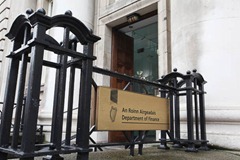Reforming corporation tax
 eolas examines the way forward for corporate taxation after the ‘double Irish’ scheme was restricted to existing firms. The knowledge development box will cut the rate for R&D operations.
eolas examines the way forward for corporate taxation after the ‘double Irish’ scheme was restricted to existing firms. The knowledge development box will cut the rate for R&D operations.
Closing the double Irish scheme to new entrants is only the end of one chapter in the story of the State’s tax incentives to inwards investors. For a start, existing companies will be able to enjoy its benefits for five more years. In addition, the new knowledge development box (KDB) may halve the corporation tax rate for companies’ R&D programmes.
The scheme has attracted long-running disapproval from the EU and OECD which reached a new level last summer when Barack Obama criticised “magically Irish” corporations which took their tax revenues beyond the reach of US authorities. Ireland’s 12.5 per cent rate compares very favourably with 29.6 per cent in Germany, 33.3 per cent in France and 40 per cent in the States.
As of 1 January, all new companies being incorporated in Ireland must also be tax-resident in the State unless an exception is provided by a bilateral tax treaty. Ireland is currently party to 86 double taxation treaties – listed at www.revenue.ie
The tax residency rule reduces the scope for multi-nationals to transfer royalty payments – typically for ICT or pharmaceutical products – into Ireland and onwards to a tax haven. Revenues from Google ‘travel’ from the UK to Ireland and then to Bermuda. The change in policy coincides with European Commission tax investigations into Apple and Google but these firms – along with other companies with existing Irish operations – will not be required to become resident until January 2021.
“Aggressive tax planning by multi-national companies has been criticised by governments across the globe and has damaged the reputation of many countries,” Finance Minister Michael Noonan said on Budget Day. “This proactive change will not bring an end to international tax planning; that requires co-ordinated action by all countries. By taking action now and making this change as part of a broader reform of our corporate tax system, we are giving certainty to investors about corporate tax in Ireland for the next decade.”
Multilateral tax reform has gathered momentum since the start of the financial crisis and alongside the backlash against profiteering, tax evasion and tax avoidance. The double Irish arrangement was very much in the latter category – potentially unethical rather than unlawful – and facilitated inward investment and job creation. However, the impact on tax take has attracted growing criticism from the left and the right which reflects the broad public mood.
In her recent interview with eolas, for example, Lucinda Creighton criticised a “heavy reliance on foreign direct investment [with] as many loopholes as possible for multi-nationals to avoid paying tax.” By comparison, she implied, indigenous companies were unable or unwilling to transfer their revenues outside the State.
Inside the box
A political consensus on tax avoidance has enabled more international action but tax rates, by the nature of business, remain a key factor in investment decisions. The KDB will therefore attract considerable interest from corporates and tax advisors alike.
By lowering tax rates on R&D-related activities, the policy is designed to compensate for possible divestment from Ireland and therefore offset any adverse impact on the economy. EU and OECD officials view the procedure with suspicion, as it can distort competition between economies, but prefer to regulate these schemes rather than prohibit them as they can encourage innovation.
Noonan has indicated support for a 6.25 per cent rate, likely to take effect in Budget 2016.
The Department of Finance consultation closes on 8 April and the Government envisages that the tax will be based on the modified nexus model – already suggested by the EU and OECD. This should make the scheme comparable with others (e.g. the UK patent box) and also deflect external criticism in future.
Respondents are asked for their views on how to define qualifying expenditure, overall expenditure and ‘IP income’ and also how to support SMEs. The modified nexus is a variation on the principle that R&D tax credits should be linked to the creation of IP. It also allows income arising out of intellectual property to benefit through the tax system provided that there is a “direct nexus” between the income receiving those benefits and the expenditures contributing to that income. This acts as a proxy for the level of “substantial activity” carried out by the tax-payer in a particular jurisdiction.
As a rule, the proportion of qualifying expenditure (of the overall expenditure) is multiplied by the overall income from the IP asset to calculate the level of income receiving the tax benefits. Tax-payers would be able to suggest that more income should be permitted to benefit if they could show a direct link between income and qualifying expenditures.
Significantly, qualifying tax-payers would include resident companies, domestic permanent establishments of foreign companies, and foreign permanent establishments of resident companies. The tax residency rule would therefore be waived.
Patents and other assets that are effectively equivalent to patents are the only IP assets that can qualify for tax benefits. Marketing-related IP assets such as trademarks cannot qualify.
Qualifying expenditures would include those expenditures which are currently granted R&D credits but would not include interest payments, building and acquisition costs, or any costs that could not be directly linked to a specific IP asset.
In a final caveat, countries may allow for an uplift in qualifying expenditure related to acquisition costs and outsourcing expenses if two conditions are met: acquisition costs and outsourcing costs have actually been incurred; and the uplift is limited to 30 per cent of qualifying expenditures incurred.
Noonan has stated that “Ireland will play fair, as we have always done, and play to win.” The overall assessment of tax fairness, though, will rest with the international organisations which are taking an ever-increasing interest in the State’s tax affairs.
Northern ambitions to lower rate
The success of the State’s corporation tax policy is now leading to the devolution of the rate in the North with a view to lowering it. The proposal is officially backed by the five governing parties but will inevitably reduce the £11 billion (€14 billion) block grant from London. The main UK-wide corporation tax has fallen from 28 to 21 per cent since the Conservatives came to power in 2010. A 20 per cent rate applies to companies declaring profits of under £300,000 (€405,000).
The Corporation Tax (Northern Ireland) Bill must be passed before the UK general election on 7 May. Westminster would remain responsible for reliefs and allowances and taxes on profits from reinsurance and the offshore oil and gas sector – to prevent profit-shifting from the City and firms operating in the North Sea. The main Westminster parties want to retain a standard corporation tax rate across Great Britain but Scottish nationalists are calling for devolution to Edinburgh as well.





